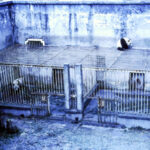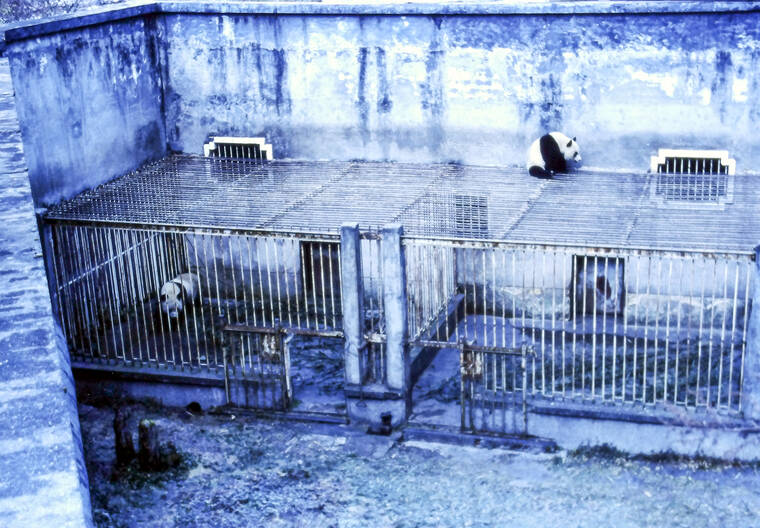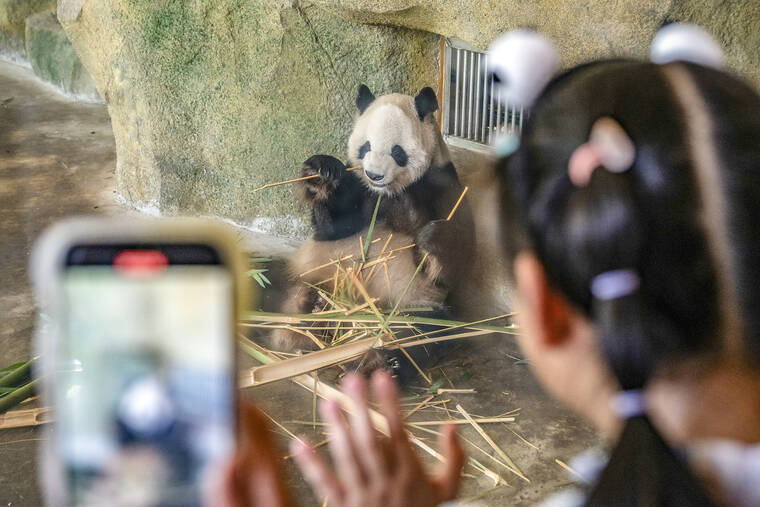The panda factories


WASHINGTON — Two chunky pandas, a male and a female, arrived from China this week at the National Zoo in Washington. If everything goes as planned, they will eventually have cubs.
Exchanges like this have helped turn giant pandas into the face of conservation worldwide.
ADVERTISING
The panda program was created with the stated goal of saving a beloved endangered species. Zoos would pay up to $1.1 million a year per pair, which would help China preserve the pandas’ habitat. By following carefully crafted breeding recommendations, zoos would help improve the genetic diversity of the species.
And someday, China would release pandas into the wild.
But a New York Times investigation, based on more than 10,000 pages of documents, has found that Chinese authorities and U.S. zoos have put a rosy sheen on a program that has struggled, and often failed, to meet those objectives. The records, photographs and videos — many of them from the Smithsonian Institution Archives — offer a detailed, unvarnished history of the program.
They show that, from the beginning, zoos saw panda cubs as a pathway to visitors, prestige and merchandise sales.
On that, they have succeeded.
Today, China has removed more pandas from the wild than it has freed, the Times found. No cubs born in American or European zoos, or their offspring, have ever been released. The number of wild pandas remains a mystery because the Chinese government’s count is widely seen as flawed and politicized.
Along the way, individual pandas have been hurt.
Because pandas are notoriously fickle about mating in captivity, scientists have turned to artificial breeding. That has killed at least one panda, burned the rectum of another and caused vomiting and injuries in others, records show. Some animals were partly awake for painful procedures. Pandas in China have flickered in and out of consciousness as they were anesthetized and inseminated as many as six times in five days, far more often than experts recommend.
Breeding in U.S. zoos has done little to improve genetic diversity, experts say, because China typically sends abroad animals whose genes are already well represented in the population.
Yet U.S. zoos clamor for pandas, and China eagerly provides them. Zoos get attention and attendance. Chinese breeders get cash bonuses for every cub, records show. At the turn of the century, 126 pandas lived in captivity. Today there are more than 700.
Kati Loeffler, a veterinarian, worked at a panda breeding center in Chengdu, China, during the program’s early years. “I remember standing there with the cicadas screaming in the bamboo,” she said. “I realized, ‘Oh, my God, my job here is to turn the well-being and conservation of pandas into financial gain.’”
Loeffler, who spent part of her time in Chengdu as a scholar affiliated with the National Zoo in Washington, said that scientists there used anesthesia excessively and sloppily. At one point, she said, she bucked protocol and jumped onto an examination table to cradle an animal as it was being anesthetized.
Kimberly Terrell, who was director of conservation at the Memphis Zoo until 2017, said, “There was always pressure and the implication that cubs would bring money.” She noted that zoo administrators insisted on inseminating its aging female panda every year, despite concerns among zookeepers that it was unlikely to succeed. It never did.
“The people who actually worked day to day with these animals, who understand them best, were pretty opposed to these procedures,” she said. The zoo said its breeding efforts followed all program requirements.
The Times collected key documents and audiovisual materials from the Smithsonian archives and supplemented them with materials obtained through open-records requests. The trove, which spans four decades, includes medical records, scientists’ field notes and photographs and videos that offer crucial evidence of breeding procedures, side effects and the conditions in which pandas were held.
They show that the riskiest techniques happened in the program’s infancy, but that aggressive breeding continued at the National Zoo and at other institutions for years. A panda in Japan died during sperm collection in 2010. Chinese breeding centers, until recently, separated cubs from their mothers to make the females go back into heat.
This panda proliferation has prompted debates among zoo workers and scientists over whether it is ethical to subject animals to intensive breeding when they have no real prospect of being released into the wild. At the center of this story is the National Zoo, which is part of the Smithsonian. Pandas have been part of the zoo’s image since 1972, when President Richard M. Nixon traded a pair of musk oxen for two bears after his historic trip to China. But the Smithsonian has glossed over the reality of artificial breeding, at times in partnership with the Chinese propaganda apparatus, records show.
A National Zoo spokesperson, Annalisa Meyer, acknowledged that efforts to release pandas into the wild were “still developing,” and she said that the program’s success could not be measured in the number of animals released. She said that pandas in zoos were “insurance against extinction” and that animal safety was a top priority.
The panda program was supposed to fix abuses.
In the 1980s, China sent pandas for short stints to foreign zoos, where they rode bicycles and pushed trolleys, like carnival sideshows. Many had been caught in the wild. It took a lawsuit for U.S. regulators to intervene.
After years of negotiation, American zoos and the Chinese government struck a deal, and the U.S. Fish and Wildlife Service issued a policy in 1998. Zoos could rent pandas for a decade at a time, with the money going toward conservation.
American and Chinese scientists also agreed to jointly study panda breeding. The population in captivity showed signs of inbreeding. Artificial insemination efforts had faltered.
So, in the late 1990s and early 2000s, scientists from the National Zoo, San Diego Zoo and other institutions flew to the Chinese province of Sichuan. Archival photographs and records reveal details of trips that have seldom been discussed but that laid the foundation for breeding around the world.
Researchers shot pandas with tranquilizer darts to anesthetize them, then laid them on stretchers or boards. Scientists collected semen from the males by inserting electrified probes into their rectums.
They called themselves the “Sperm Team.”
This technique, called electroejaculation, is commonly used in captive breeding. But the scientists drugged some of the animals with unadulterated ketamine, a powerful sedative that veterinarians typically use in combination with other drugs. Ketamine alone can leave an animal anxious and in pain — and partly awake, as a National Zoo veterinarian acknowledged in a presentation at the time.
Some pandas were “light,” meaning they were insufficiently anesthetized, and apparently struggled.
“Animal was light during entire procedure,” JoGayle Howard, a scientist at the National Zoo, wrote in a journal she kept on a 1999 trip. “Almost came off table at one point (used ketamine only this time instead of ketamine and xylazine).”
During one collection, Howard wrote that Chinese scientists had quadrupled the voltage to an unsafe 12 volts.
“They used dangerously high voltages and too many stimulations on male Ping Ping after we left,” she wrote. “Male had bloody loose stool and no appetite for months.”
Experts say that electroejaculation should be done cautiously, with minimal voltage. “You can do quite a lot of harm,” said Thomas Hildebrandt, an expert on artificial breeding in animals at Leibniz Institute for Zoo and Wildlife Research in Berlin.
The Chengdu Research Base of Giant Panda Breeding, which today owns one-third of the world’s captive pandas, denied ever using excessive voltage or otherwise harming animals. “We have not had any giant pandas suffer health damage or death during surgery due to the use of ketamine,” the center said in a statement.
Notes in the Smithsonian archive show that American scientists accidentally injured one panda’s uterus during an examination. Photographs show pandas vomiting. “Difficult anesthesia,” scientists wrote about a female panda named Lei Lei at a breeding center in Wolong, western China. “Retching and vomiting. Inadequate fasting — food and water. Procedure cut short.”
Notes make clear that the scientists did not intend to harm the animals. They believed they were saving the species. In conservation efforts, the welfare of the species often trumps that of individual animals.
When they are old enough, pairs of Chinese pandas are eligible to be rented.
Under the policy governing the rental program, zoos may not profit from pandas.
But records show that, even as the program details were being hashed out, money was at the center of the discussion.
In 1993, zoo representatives from the United States and Europe gathered at the National Zoo to strategize.
The notes from that meeting are full of typos, but they show that zoo administrators were not interested in only displaying a rare species. They wanted cubs, referring to the agreements as “breeding loans.”
“Old males,” said a National Zoo scientist at the meeting, are not “going to bring in as much money as a breeding pair.”
Today, U.S. zoos must submit audits of their panda-related revenue to the Fish and Wildlife Service to prove that they are not profiting. Pandas are expensive. Beyond rent to China, zoos also have to build sophisticated enclosures and buy tons of bamboo.
In 1999, before its last pandas arrived, the National Zoo launched a $13 million fundraising campaign, which included $10.5 million for what it called an “education center.”
An internal document from that period advised employees to deflect a journalist’s questions about the project’s planned gift shop, restaurant, special events area and fundraising offices. The building is the zoo’s “investment in the future of wildlife on Earth,” the document reads. “So that’s why we want to build the ed facility!”
The zoo, a nonprofit, does not charge for admission. But documents show that it saw pandas as a way to “form strong collaborations with area businesses.”
It brokered panda sponsorship deals with Fujifilm and Animal Planet; worked with local hotels to create packages that included zoo donations; and sourced panda mouse pads, golf balls and shot glasses for the gift shops.
Within months of the pandas Mei Xiang and Tian Tian arriving, 1 million visitors had come through the gates.
One of the great hopes of the panda program was that someday, animals bred in captivity would be freed to repopulate the wild.
Ten pandas have successfully been released, a number that is touted by China’s national forestry bureau. But nearly as many have died in the process, the Times found in an analysis of news reports. Two died in the wild from attack or infection and another six died in a prerelease program.
Since 1995, more pandas have been removed from the wild than have been released, the Times found. Forestry workers said they collected pandas that were injured or abandoned. But once in captivity, many pandas were added to the breeding program, according to records.
The Times counted over a dozen wild pandas that remained in captivity for the rest of their lives, and a dozen more that remain there today. In 2018, China tried to address this by requiring that newly caught animals be released once they have recovered.
The forestry bureau did not answer a list of questions but said that the Times “distorted the reality of giant panda protection and management in China.”
Pandas who spend most of their lives in overseas zoos are never freed. Neither are their foreign-born cubs.
This article originally appeared in The New York Times.
© 2024 The New York Times Company






